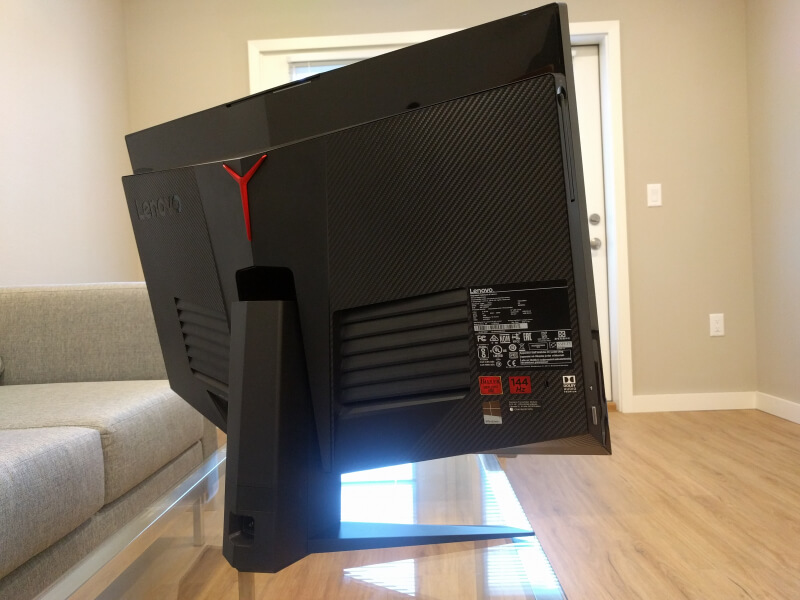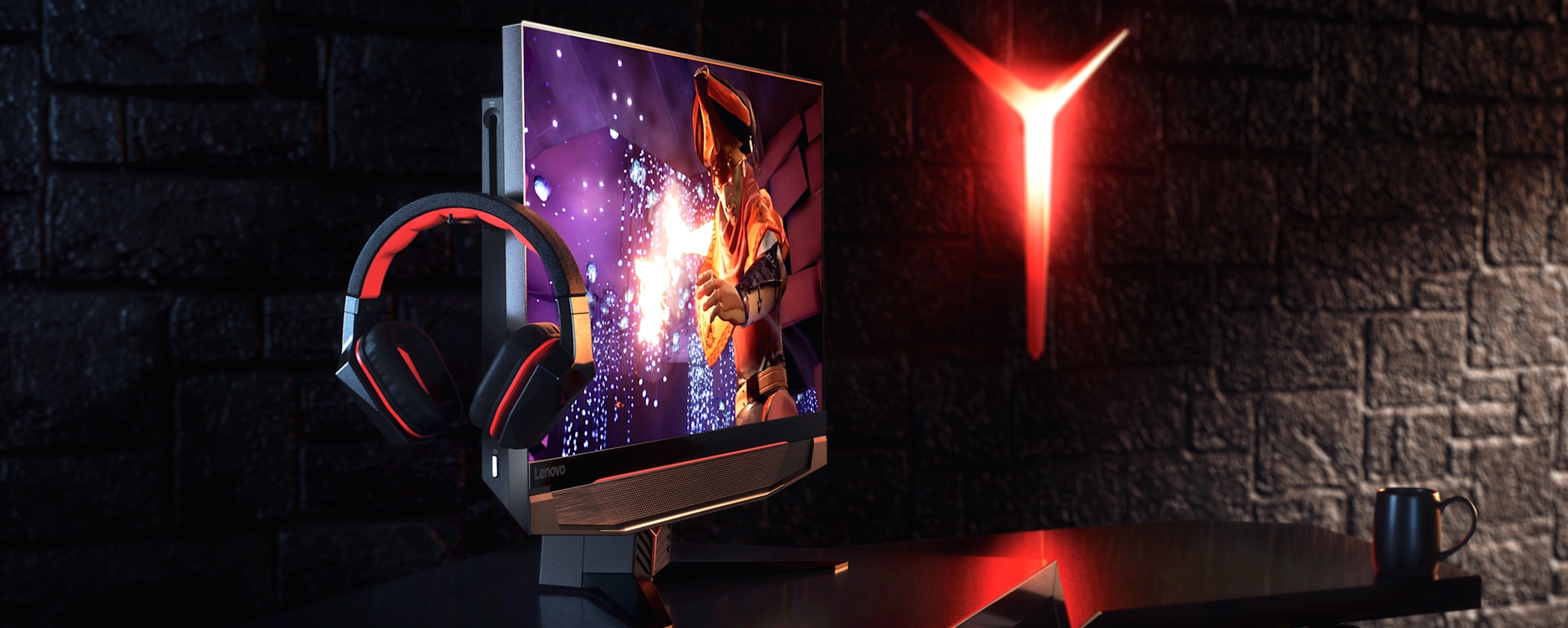All-in-One computers aren't traditionally known for offering gaming-grade processing power. Their cramped internal space provides less flexibility compared to a traditional desktop and that often means compromising with lower end components. This tradeoff between size and performance isn't for everyone, but there certainly are many cases where an AIO is the perfect solution.
The Apple iMac dominated the AIO scene for years with a stunning design and beautiful display, but there are now a number of great options on the Windows side, and the amount of performance you can squeeze into the back of a monitor has increased considerably, too.
Today I'll be checking out the IdeaCentre Y910 Gaming AIO from Lenovo. Available in two different models, it promises top-of-the-line gaming performance in a compact form factor.
The base $1,800 model packs a Core i5-6500 processor, GeForce GTX 1070 8GB GPU, 12GB of DDR4 2133MHz RAM, a 1TB HDD, and a 128GB PCIe SSD. The higher end model that I'll be checking out today comes with a Core i7-6700 processor, a GTX 1080 8GB GPU, 16GB of DDR4 2133MHz RAM, a 2TB HDD, and finally a 256GB PCIe SSD.

With a base price of $1800, the Y910 isn't exactly the most affordable option for budget-conscious gamers, an additional GTX 1060 model with 8GB of RAM could be added to the lineup, but regardless, this is one powerful AIO for sure, especially thanks to the Pascal graphics inside.
The first thing that struck me when I unpacked the Y910 was how thin the bezels are. Lenovo has managed to cram all of the display processing circuitry into the base of the monitor, removing virtually all of the other three bezels. The construction at first glance is nice and appears high quality. There are silver and red accents on the base of the unit that also serve as the Y910's built in speaker system.
From the front, the Y910 looks just like a standard 27" monitor. The back is wedge shaped with two distinct and removable rear panels. To save on space, Lenovo has opted to turn the monitor stand into the actual power supply, negating the need for an external power brick since everything is built right in. Given the power needs of the internal components, I think this was a really good idea.

The I/O panel is split into two layouts. On the rear and towards the bottom we find an HDMI in, HDMI out, two USB2.0 ports, a gigabit network jack powered by Killer, and the standard AC power plug.
The inclusion of a video output here allows for a second auxiliary monitor, while the HDMI in port allows for the Y910 to be used as a standalone monitor. If you outgrow the performance or just want to plug in another media device, you can still take advantage of the 27-inch, 144Hz 2650x1440 monitor.

On the user's right side is the second set of ports. From top to bottom we have two USB 3.0 ports, an SD card reader, a headset jack, a microphone input, two more USB 3.0 ports (one with fast charging support) and finally a slim CD drive. Lenovo offers a decent array of ports but in place of the outdated optical drive I'd rather see more audio options such as an optical out or line out for speakers.
Given the AIO has either a GTX 1070 or GTX 1080, a second DisplayPort video output would have been good, too. This would allow for a triple monitor surround setup to take advantage of all that GPU power. Putting most of the connectors on the side isn't the best for cable management if you need more than the two USB ports so I would put that as another area for improvement.

Internal Hardware and Peripherals
Out of the box the Y910 comes with a warranty guide, quick start guide with diagrams of how to upgrade the internal components, a keyboard and a mouse. The keyboard and mouse really stick out in contrast to the other high quality components given the price tag of at least $1,800. They both work fine but they're not what you'd call gaming peripherals.
The keyboard is very mushy and has a peculiar layout with an extra tall delete key. It looks like they tried to save space by squishing everything together. Notice how the arrow keys are offset. The mouse feels cheap and doesn't inspire much confidence. I certainly would have expected Lenovo's Y Gaming keyboard and mouse to be included standard. Especially since they show it in the marketing images.


Moving inside is a much better experience, however.
To get access to the user upgradeable components, the two back panels must be removed. The red "Y" accent at the top isn't just a fashion statement; it's the quick release to remove those panels. Pressing each side removes the adjacent panel, revealing the components inside.

At the top left is the PCIe SSD slot. The cover removes with just a push, making upgrades very easy if 128GB or 256GB isn't enough for you. A single screw holds the drive in place.
PCIe SSDs like this have become the new standard for this type of machine. They are much smaller than standard SATA based SSDs and they offer three or more times the performance. The drive included in the Y910 is a Samsung PM951 model from their "Client" line of SSDs.

A full sized 3.5" hard drive fits into a custom sled and slides in without screws or additional tools. Unfortunately, the drive in our review sample did not work so I wasn't able to test it. This isn't a huge deal since these units are shipping around the country and stress tested by countless reviewers.
I was surprised to find an actual 3.5" drive considering the internal space requirements. The capacity of smaller 2.5" drives has increased so much that there isn't really a good reason not to include one in here. The space savings could have been better used for improved cooling and airflow.
On the right panel we find the memory and GPU. The RAM cover is removed in the same way as the SSD one. Inside, we find two slots for SODIMM RAM. They insert at an angle and then fold down flat just like a laptop. The top end model comes with 16GB, but you can put up to 32GB in if you want.

The last and probably most import upgradeable component is the graphics card. It's housed in a thin metal shroud behind the right back cover. Rather than using integrated or proprietary connectors, the GPU is connected with standard HDMI and DisplayPort cables. The DisplayPort drives the built in monitor, and the HDMI is for a secondary monitor. The PCI power cable is long enough to reach around.

Despite the GTX 1080 only requiring an 8 pin connector, the Y910 comes loaded with an 8+6 pin connector for future expansion. The internal power supply is only 380 Watts so be sure to consider than when putting in a new card down the road. The black metal casing is also designed specifically for a full sized Nvidia card. Smaller cards shouldn't be an issue, but can only be secured on one side of the housing. Larger cards aren't really going to fit unless you do some heavy modifications.

The GPU was the hardest component to get to. The internals are so densely packed that there just isn't much room to maneuver. The whole assembly slides out after unplugging the power and video connectors. From here, there are just four more small screws to remove and the GPU is free.
